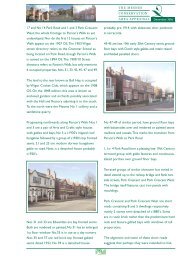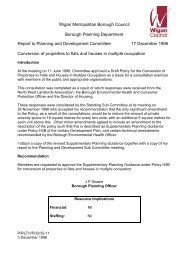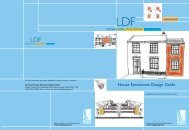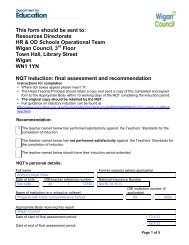A1P (1) MAJOR HIGHWAY SCHEMES - A5225 ... - Wigan Council
A1P (1) MAJOR HIGHWAY SCHEMES - A5225 ... - Wigan Council
A1P (1) MAJOR HIGHWAY SCHEMES - A5225 ... - Wigan Council
Create successful ePaper yourself
Turn your PDF publications into a flip-book with our unique Google optimized e-Paper software.
development which might prejudice its construction. The route shown on the proposals<br />
map of the adopted UDP approximates to, while not exactly coinciding with, that on the<br />
proposals map of the RDD.<br />
10.140 In the section of this report which relates to policy <strong>A1P</strong>(1) I refer to the<br />
national and regional planning guidance which provides the framework for decision<br />
making. In particular the provisions made in development plans for safeguarding<br />
transport routes should be realistic about the prospects for a start during the plan period<br />
and be sensitive to the implications of blight.<br />
10.141 The LPA’s arguments in respect of the impact of the ANB on the existing<br />
highway network are limited to the single generalised assertion that ‘the construction of<br />
the road is going to relieve Ashton town centre of some traffic’. Objectors draw my<br />
attention, however, to a study carried out by the Greater Manchester Transport Unit<br />
(GMTU) in 1995 (CD42) to create and validate a traffic model for Ashton-in-Makerfield<br />
to assess various traffic relief proposals for the town centre. Among the options<br />
considered was the construction of the ANB along an alignment exactly as presented on<br />
the RDD proposals map.<br />
10.142 The study noted that the centre of Ashton-in-Makerfield lies at the<br />
junction of the busy A49 and A58 roads, both of which carry high proportions of through<br />
traffic. Approximately 10% of traffic on these roads consists of goods vehicles of 1.5<br />
tonnes un-laden weight and above. This compares with the Greater Manchester average<br />
of 5.5%. In addition a number of main junctions in the town centre are of sub-standard<br />
geometry. Consequently they suffer from congestion, particularly in the peak periods.<br />
The report of the study commented that the problems caused by heavy vehicular flows<br />
and the high percentage of HGVs were particularly severe on Gerrard Street, the main<br />
shopping street, where pedestrians suffer noise, pollution, severance and danger. At the<br />
inquiry the LPA conceded that no action had been taken since the time of the study which<br />
would have relieved the problem to any appreciable extent.<br />
10.143 Upon testing the proposed ANB, even with traffic restraint measures in the<br />
town centre, it was found that it simply diverted traffic from the B5207 Bryn Road. This<br />
road runs parallel to the proposed bypass from the A58 in the south to the A49 in the<br />
north, where it joins that latter highway at a point a little over 1km to the south of where<br />
the proposed bypass would join it. Traffic flows through the town centre fell by very<br />
little. The study concluded that the construction of the ANB was the most expensive of<br />
the options considered and that it failed to achieve any of the objectives of the study. It<br />
expressed the view that the construction of a scheme of this magnitude and expense could<br />
not be justified, given the lack of relief from through-traffic which would be experienced<br />
in the town centre. At the inquiry the LPA confirmed that it accepted the conclusions of<br />
this report.<br />
10.144 The reasons for the lack of traffic relief in the town centre lie in the layout<br />
of junctions 24 and 25 of the M6 motorway which, respectively, lie to the south west and<br />
north west of the town. The slip road layout at junction 24 allows access only to traffic to<br />
425

















